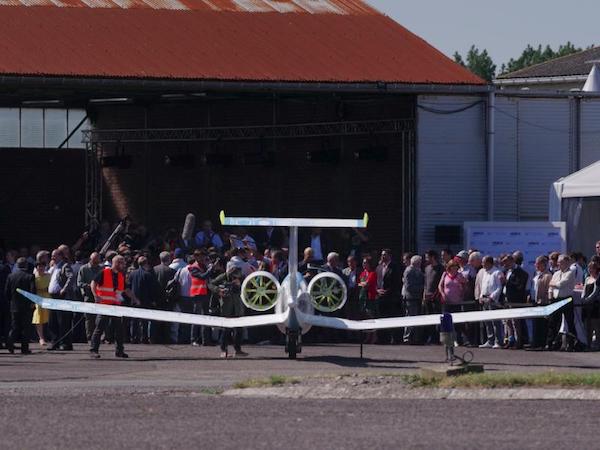
The Airbus E-Fan Demonstrator. Photo: Airbus.
In the near future, commercial aviation could see disruptive technologies, such as airline cabin passenger configurable modules, autonomous air taxis and a hybrid electric powered airframe the size of an A320, said Paul Eremenko, CTO of Airbus. On the second day of the 2017 American Institute of Aeronautics and Astronautics (AIAA) Aviation Forum, Eremenko discussed these and other disruptive technologies and innovative concepts that the French original equipment manufacturer (OEM) is currently researching.
Eremenko admitted that all segments of aviation have traditionally lagged behind other industries, in terms of introducing new and innovative technologies, due to the stringent levels of certification they’re required to meet. But he said Airbus is looking to lead the charge as aviation enters new areas and modes of transportation and technological capabilities in the future.
“We’re used to being the masters of our technological destiny, to being the drivers of key technologies needed to make each successive generation of our products,” Eremenko said. “And suddenly we find that consumer electronics, automotive and other industries outspend, outpace and out-innovate us in digital, electrical and manufacturing technologies.”
Eremenko, hired by Airbus in 2015 to serve as CEO of its outpost, A3, after serving as director of engineering at Google, was promoted to CTO of Airbus in 2016. However, he has worked in aerospace in the past. During his AIAA speech, he pointed to three periods of aerospace revolution: the first occurring with the Wright Brothers first flight, the second occurring in the 1950s with the dawn of the jet age and the third one occurring right now with drones, electric powered aircraft and new concepts for vertical flight.
The bulk of research and development around electric propulsion aircraft at Airbus is occurring at its E-Aircraft System House in Munich, Germany. Interest in developing hybrid and electric propulsion aircraft for Airbus is motivated by the goal of reducing aircraft emissions and noise.
The airframe manufacturer’s primary partner in this pursuit is Siemens, which, jointly with Airbus, conducted the first flight of its serial hybrid aircraft, the E-Star, in 2013. This aircraft featured a 30-kilowatt internal combustion engine running at constant speed, and a 70-kilowatt electric motor enabling the ability to “downsize the power generation for cruise while augmenting it with stored electric energy for takeoff and climb,” according to Eremenko.
Today, Siemens is flying a much more powerful electric demonstrator aircraft known as the “Extra,” which is an aerobatic aircraft modified to fly with an electric motor . It delivers 260 kilowatts of power in a 50-kilogram package, with 10 times the power of the previous generations of electric aircraft demonstrators used by Siemens and Airbus.
Later this year, Airbus expects to conduct the first hover flight of Vahana, its electric powered, single-passenger autonomous vertical takeoff and landing, passenger-carrying aircraft. To develop Vahana as a product demonstrator, Airbus is primarily using commercial off the shelf (COTS) technologies.
CityAirbus is the next step in progression for electric powered aircraft ambitions at Airbus, which Eremenko described as a four-seat, all electric vertical takeoff and landing (VTOL) aircraft, and the “flagship” of the Airbus urban mobility division. The first flight of CityAirbus is expected to occur in 2018. It is currently being developed at the E-Aircraft Systems House, which is capable of testing power systems in excess of 20 megawatts.
Eremenko said the ultimate goal, though, is the development of a completely new, single-aisle aircraft, powered by hybrid electric propulsion technology. In pursuit of that goal, Airbus is working toward the development of a demonstrator aircraft known as the “E-Fan X.”
“A few years ago the state of the art of flight weight components were measured in the 10s of kilowatts. Today it is in the 100s of kilowatts, and we believe with a strong push we could demo a two-megawatt flight weight hybrid electric power system in about three years,” Eremenko said.
“The ultimate prize for us is to enable a hybrid electric propulsion architecture for a single-aisle aircraft at the scale of an A320 family. This takes us into the power range of around 20 megawatts for cruise and 40 megawatts for power,” he added, noting that he would not predict a date for the first flight of such an aircraft.
Eremenko admitted that as of today, a hybrid power chain is less efficient than a conventional gas turbine engine because it includes the additional steps of converting to and from electrical energy. Therefore, he believes Airbus and others will have to find increased efficiencies in other areas for this concept to become a desirable product.
But Eremenko and Airbus already see other areas that can derive increased efficiency as a result of the use of hybrid electrical power. For example, simplifying the onboard systems required to power airframes and enable fundamentally different aircraft configurations.
“For the first time since the jet age of passenger aviation … we’re really thinking about opening up the design trade space, beyond the tube and wings configurations,” Eremenko said. “Hybrid propulsion enables us to think about distributed thrusters, creating a blown wing effect that could allow shrinking the wing area, or using differential thrust to control the yaw of the aircraft, reducing the vertical tail surface, or boundary level ingestion to re-ingest the wake at the tail of the airplane cutting the overall drag by up to 10%.”